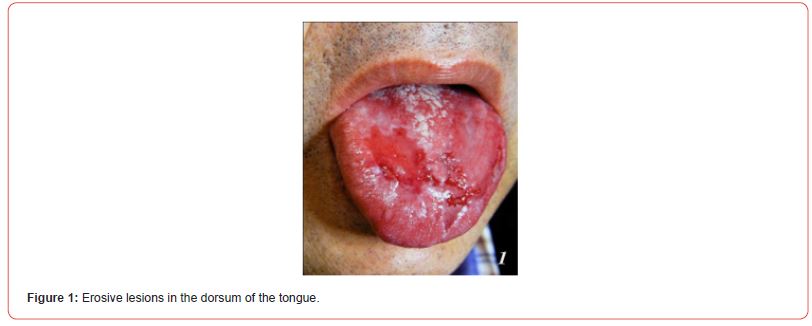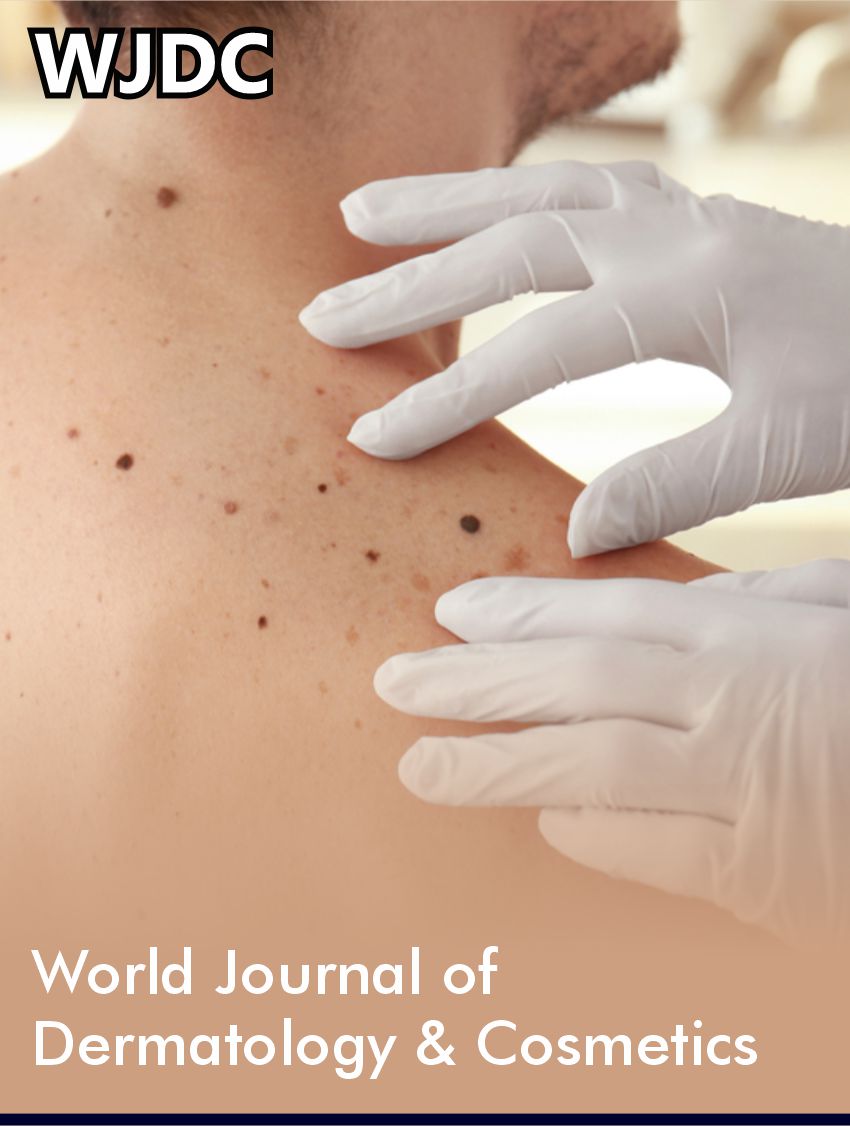 Case Report
Case Report
Oral Erosive Lichen Planus Successfully Treated with Ivig
Cagdas Boyvadoglu1 and Huseyin Serhat Inaloz2*
1Department of Dermatology, Ceyhan State Hospital, Adana, Turkey
2Department of Dermatology, University of Gaziantep Faculty of Medicine, Gaziantep, Turkey
Huseyin Serhat Inaloz, Department of Dermatology, University of Gaziantep Faculty of Medicine, Gaziantep, Turkey.
Received Date: April 06, 2023; Published Date: April 26, 2023
Abstract
Oral lichen planus is a chronic inflammatory disease with mainly reticular, erythematous, atrophic, or erosive forms. Oral lichen planus is often asymptomatic, but in erosive forms it can often lead to discomfort. The erosive form is especially important because of its malignant potential. Although IVIg is an expensive treatment option, it should be kept in mind as an effective treatment for patients with severe erosive lichen planus who do not respond to immunosuppressive treatments. Here, we present a patient with oral lichen planus who had severe erosive lesions resistant to other treatment options and responded to IVIg therapy.
Keywords: Lichen planus; Oral erosive lichen planus; IVIg; Case report
Introduction
Lichen planus is an inflammatory dermatosis that can affect the skin, mucosa, scalp, or nails. Mucosal lesions are important because of their chronic course, lack of tendency to heal spontaneously, being more resistant to treatment, having symptoms such as pain and burning as well as pruritus, and some forms tend to become malignant [1]. Our case was also that of an oral lichen planus patient with severe erosive mucosal lesions resistant to current treatments. Significant improvement was observed in our patient, who started IVIg treatment due to the ineffectiveness of current treatments. Herein, we present a case of using IVIg therapy for erosive oral lichen planus.
Case Presentation
A 65-year-old male patient was admitted to our outpatient clinic with complaints of a wound in the mouth and difficulty eating and drinking that started fifteen years ago. Dermatologic examination revealed erosive lesions in the buccal mucosa and the dorsum of the tongue (Figure 1). He had no signs or symptoms in his skin or nails. There was no systematic complaint from the patient, and he did not have any features in his personal and family history. He had previously used antibacterial and antifungal mouthwashes, systemic corticosteroids, topical tacrolimus, colchicine, methotrexate, and systemic cyclosporine, but no improvement was observed. A biopsy was taken for a definite diagnosis from the dorsum of the tongue, where the lesion was widespread. In the histopathological examination of the tissue, an acanthotic multilayered flat epithelium, intense inflammatory cell infiltration in the form of a dermal band, exudate, and fibrin accumulation were observed in place of a fully drained tongue epithelium in a particular area (Figure 2). With these clinical and histopathological findings, the patient was diagnosed with erosive lichen planus.


IVIg treatment was initiated in the form of monthly cures with a total dose of 2 g/kg in five consecutive days. A significant improvement in oral mucosa was observed, and there was a decline in the ulcerative plaques (Figure 3) in the fifth dose of the patient, who underwent a total of nine cycles of IVIg treatment.

Discussion
Oral lichen planus is a chronic inflammatory disease with mainly reticular, erythematous, atrophic, or erosive forms. The frequency ranges from 0.2 to 2.3%. Oral lichen planus occurs mostly in the fifth and sixth decades. It develops more frequently in women. The lesions are often seen in the buccal mucosa but also in the tongue, palate, gingiva, and lips. Because of Köbner’s phenomenon, lesions may be seen in the trauma area of the oral cavity. Emotional stress, dental interventions, dental plaque, irritation from tobacco products, pointed teeth friction, inappropriate dental prostheses, habits such as cheek-lip biting, poor hygiene, and amalgam fillings can be among the factors triggering oral lichen planus development [1]. Oral lichen planus is often asymptomatic, but in erosive forms it can often lead to discomfort. The erosive form is especially important because of its malignant potential [2].
IVIg is the preferred immunosystem regulatory agent in immunocompromised patients. There have been numerous recent advances in our understanding of the mechanisms of action of IVIg in many of the auto-immune conditions for which it is being used. But the mechanism of action is not completely known. It is used in the treatment of certain dermatological diseases such as pemphigus vulgaris, atopic dermatitis, pyoderma gangrenosum, and psoriasis, as well as many hematological, neurological, and rheumatic diseases [3]. There are few reported cases where IVIg treatment is used for erosive oral lichen planus [4]. A patient with dermatomyositis who had oral lichen planus with a leukoplakia-like appearance showed clinical improvement with IVIG treatment [5].
Our patient, who had not improved despite using many medications, observed that IVIg treatment markedly improved the oral erosive areas and the symptoms after the fifth cure. Although IVIg is an expensive treatment option, it should be kept in mind as an effective treatment for patients with severe erosive lichen planus who do not respond to immunosuppressive treatments.
Acknowledgements
Written informed consent was obtained from the patient for publication of this case report and any accompanying images.
Conflict of interest
The authors have no conflicts of interest to declare.
References
- Eisen D, Carrozzo M, Bagan Sebastian J V, Thongprasom K (2005) Number V Oral lichen planus: clinical features and management. Oral diseases 11(6): 338-349.
- Dissemond J (2004) Oral lichen planus: an overview. Journal of dermatological treatment 15(3): 136-140.
- Jolles S, Hughes J (2006) Use of IGIV in the treatment of atopic dermatitis, urticaria, scleromyxedema, pyoderma gangrenosum, psoriasis, and pretibial myxedema. Int Immunopharmacol 6(4): 579-591.
- Armin Bender, Caroline Fix, Verena Eubel, Rüdiger Eming, Robert Pollmann, et al. (2018) Adjuvant high-dose intravenous immunoglobulins for recalcitrant erosive oral lichen planus: mixed clinical responses. European Journal of Dermatology (28): 496-501.
- Geist S M R Y, Tanaka T I (2014) Oral lichen planus in a dermatomyositis patient that resolved after intravenous immunoglobulin therapy. Oral Surgery Oral Medicine Oral Pathology and Oral Radiology 118(4): e111-e114.
-
Cagdas Boyvadoglu and Huseyin Serhat Inaloz*. Oral Erosive Lichen Planus Successfully Treated with Ivig. World Journal of Dermatology & Cosmetics. 1(1): 2023. WJDC.MS.ID.000502.
-
Mucosal lesions, pruritus, colchicine, buccal mucosa, antifungal mouthwashes
-

This work is licensed under a Creative Commons Attribution-NonCommercial 4.0 International License.






